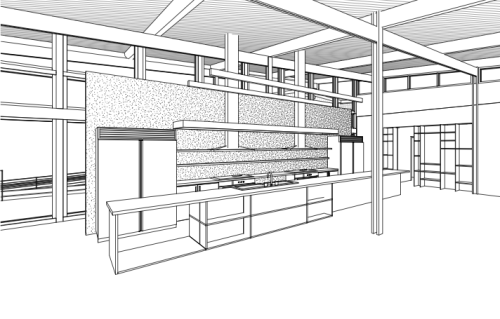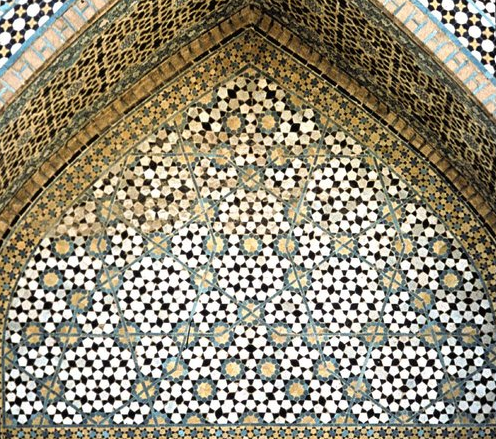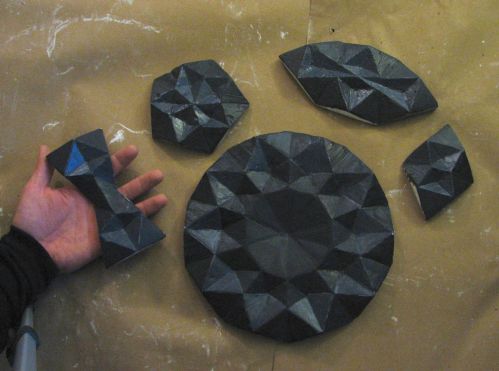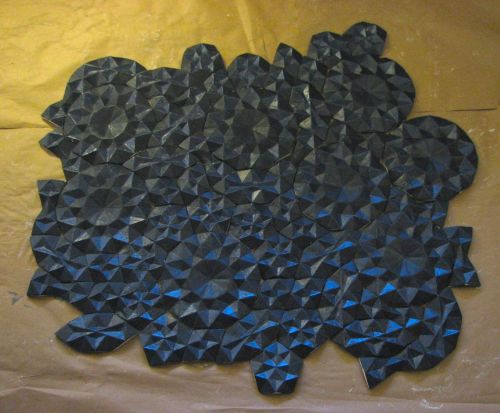some background
by Ian
This project started about a year ago, during the planning for the new Core Fellows house at Penland School of Crafts. The house will be a passive solar building, with a large, cast concrete wall inside of the heavily glazed (i.e. lots of windows) south face of the building. The function of the concrete wall is to absorb solar energy and store it during the day, then to radiate that energy out as heat at night. It acts as thermal mass, a key principal in passive solar design. You may get some sense of the layout from this preliminary rendering from architect Louis Cherry. The wall we’re concerned with is the one behind the refrigerators.
Our task, then, is to cover this wall with tiles, transforming the large concrete surface (21’x9′) into a design feature of the house without compromising its function. We will in fact get a small boost in its capacity as thermal mass by increasing the surface area of the wall with our high relief tiles.
Our tile design is inspired by a system of Middle Eastern ornament, known as “girih,” that dates back at least to the year 1200 and probably further back than that. It is used to produce some of the typically stunning mosaics of the region like this archway from the Darb-i Imam shrine in Isfahan, Iran.
For a deeper look into this system of ornament check out this video. It is a lecture by the physicist who, as a grad student, decoded its structure and explained how it was probably implemented by artisans and architects of the time. It is fascinating and intensely geeky.
We’ve maintained the footprint and the basic lines of these five “girih” tiles, but used triangular facets to make them high relief. The wall is made to be in sunlight, after all, and with the higher relief light and shadow become the major actors on this design. Here are some painted plaster prototypes that Ian made in preparation for the residency.




This is going to be gorgeous. What color will the final pieces be? Good luck my friends!
hmm. color. that’s a great mystery still. i think we’ll try lots of things and we’ll know it when we see it. any thoughts? -iph
HMMMM. TO REFLECT?—- WHITE.
to Absorb?… Black… What is the question? But, if efficiency is not the question, then pick something pretty. like lavender… or , blue…or red .. or green… or my all time favorite.
Lovely and fascinating. Looks like quite a work of art and craft. Have a wonderful time. Love, Kristin
wowzas! very interesting. keep up the blogging!
Wow! Nice work.
I am so excited to see the progress and work!! I’ll be checking in alot. Good Luck and be happy workers! It’s gonna be rad!
This is very cool. It will be fun to watch the project grow.
Best regards,
Larry Beck
Love the thoughtful combination of art, craft, and science. I’ll be watching you work with great interest.
Guys, what a great beginning, and you sure did hit the ground running. The blog is awesome. Can’t wait to see the progress.
Ian and Daniel,
The first piece looks sleek and beautiful: nice craft! I RE: color-I love the shot of the assembled black prototype where some facets are reflecting blue, like sapphires. Would daylight do that? Or maybe it would reflect the red of the rising sun! Love seeing the progress, thanks!
Cool work, as usual. Thanks for sharing and glad to hear you’re doing well, d!
Anonymous, aka Erin, oops.
Looks like a fun and time intensive project! The way the light/color hits the angles of the tile is very beautiful. Keep up the good work!
Hey, thanks for sharing your adventure. You keep updating the site and I’ll keep readin’ it. Looks like a great project. Enjoy exciting Racine, too.
[…] Click here to read on. And be sure to bookmark Ian’s blog for all the developing action! […]
Hi guys. It looks like you are having a great time, learning lots and looking forward to all your experiences. Thank you for sharing.
We miss you guys down here! Keep up the great work and reading these posts keeps us connected to you. This piece will be available for so many into the future!
NOW, get back to work and I mean it!